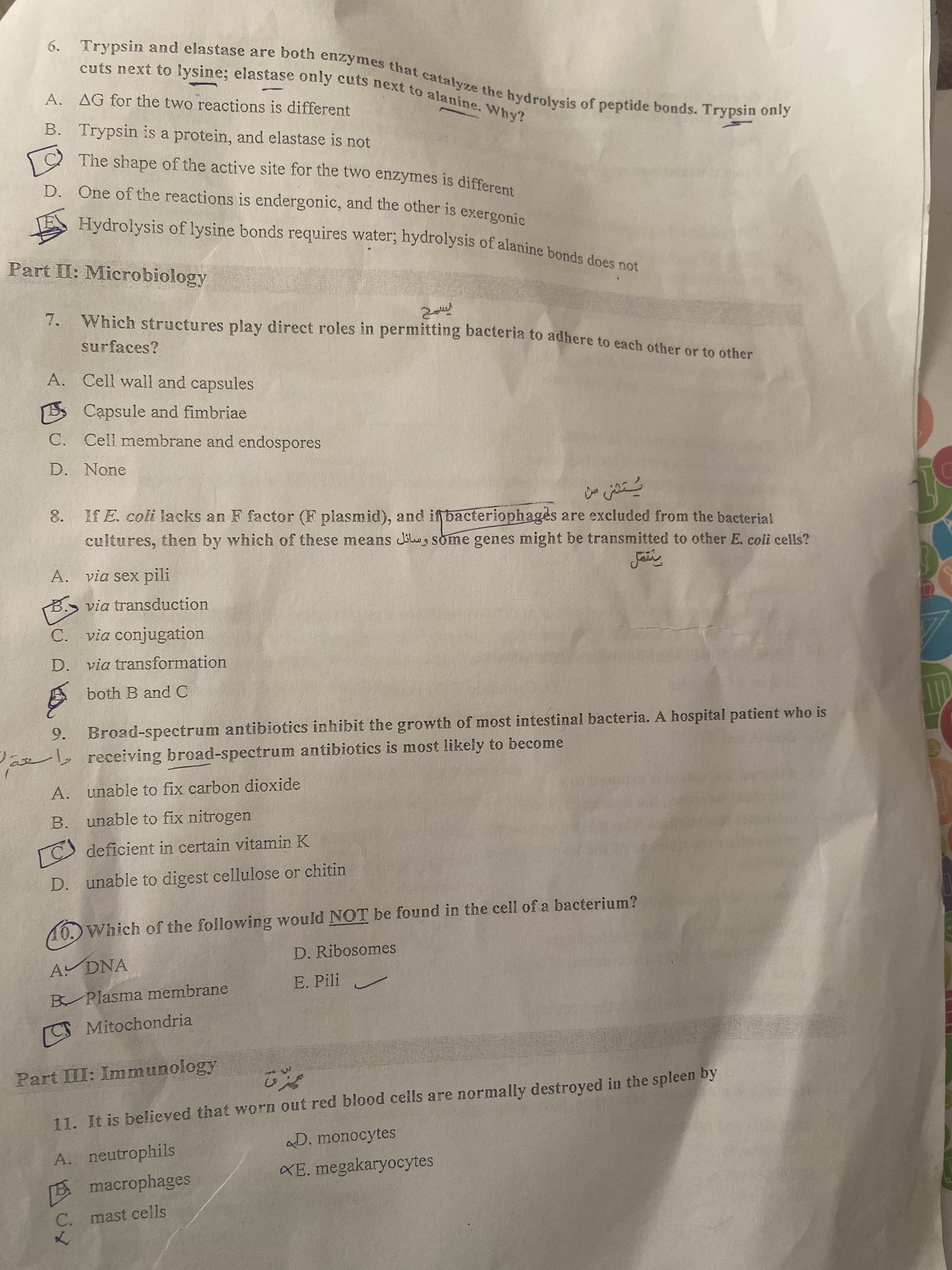A. AG for the two reactions is different B. Trypsin is a protein, and elastase is not D. One of the reactions is endergonic, and the other is exergonic Hydrolysis of lysine bonds requires water; hydrolysis of alanine bonds des Part I: Microbiology 7. Which structures play direct roles in permitting bacteria to adhere to each other or to other surfaces? A. Cell wall and capsules B Capsule and fimbriae C. Cell membrane and endospores D. None 8. If E. coli lacks an F factor (F plasmid), and if bacteriophages are excluded from the bacterial cultures, then by which of these means Jilug some genes might be transmitted to other E. coli cells? A. via sex pili via transduction C. via conjugation D. via transformation both B and C 9. Broad-spectrum antibiotics inhibit the growth of most intestinal bacteria. A hospital patient who is Jas receiving broad-spectrum antibiotics is most likely to become A. unable to fix carbon dioxide B. unable to fix nitrogen deficient in certain vitamin K D. unable to digest cellulose or chitin 10. Which of the following would NOT be found in the cell of a bacterium? D. Ribosomes A DNA E. Pili B Plasma membrane CS Mitochondria Part III: Immunology 11. It is believed that worn out red blood cells are normally destroyed in the spleen by D. monocytes A. neutrophils XE. megakaryocytes B macrophages C. mast cells
A. AG for the two reactions is different B. Trypsin is a protein, and elastase is not D. One of the reactions is endergonic, and the other is exergonic Hydrolysis of lysine bonds requires water; hydrolysis of alanine bonds des Part I: Microbiology 7. Which structures play direct roles in permitting bacteria to adhere to each other or to other surfaces? A. Cell wall and capsules B Capsule and fimbriae C. Cell membrane and endospores D. None 8. If E. coli lacks an F factor (F plasmid), and if bacteriophages are excluded from the bacterial cultures, then by which of these means Jilug some genes might be transmitted to other E. coli cells? A. via sex pili via transduction C. via conjugation D. via transformation both B and C 9. Broad-spectrum antibiotics inhibit the growth of most intestinal bacteria. A hospital patient who is Jas receiving broad-spectrum antibiotics is most likely to become A. unable to fix carbon dioxide B. unable to fix nitrogen deficient in certain vitamin K D. unable to digest cellulose or chitin 10. Which of the following would NOT be found in the cell of a bacterium? D. Ribosomes A DNA E. Pili B Plasma membrane CS Mitochondria Part III: Immunology 11. It is believed that worn out red blood cells are normally destroyed in the spleen by D. monocytes A. neutrophils XE. megakaryocytes B macrophages C. mast cells
Biology: The Dynamic Science (MindTap Course List)
4th Edition
ISBN:9781305389892
Author:Peter J. Russell, Paul E. Hertz, Beverly McMillan
Publisher:Peter J. Russell, Paul E. Hertz, Beverly McMillan
Chapter26: Prokaryotes: Bacteria And Archaea
Section: Chapter Questions
Problem 7TYK: Penicillin, an antibiotic, inhibits the formation of cross-links between sugar groups in...
Related questions
Question

Transcribed Image Text:A. AG for the two reactions is different
B. Trypsin is a protein, and elastase is not
D. One of the reactions is endergonic, and the other is exergonic
Hydrolysis of lysine bonds requires water; hydrolysis of alanine bonds des
Part I: Microbiology
7. Which structures play direct roles in permitting bacteria to adhere to each other or to other
surfaces?
A. Cell wall and capsules
B Capsule and fimbriae
C. Cell membrane and endospores
D. None
8.
If E. coli lacks an F factor (F plasmid), and if bacteriophages are excluded from the bacterial
cultures, then by which of these means Jilug some genes might be transmitted to other E. coli cells?
A. via sex pili
via transduction
C. via conjugation
D. via transformation
both B and C
9.
Broad-spectrum antibiotics inhibit the growth of most intestinal bacteria. A hospital patient who is
Jas receiving broad-spectrum antibiotics is most likely to become
A. unable to fix carbon dioxide
B. unable to fix nitrogen
deficient in certain vitamin K
D. unable to digest cellulose or chitin
10. Which of the following would NOT be found in the cell of a bacterium?
D. Ribosomes
A DNA
E. Pili
B Plasma membrane
CS Mitochondria
Part III: Immunology
11. It is believed that worn out red blood cells are normally destroyed in the spleen by
D. monocytes
A. neutrophils
XE. megakaryocytes
B macrophages
C. mast cells
Expert Solution
This question has been solved!
Explore an expertly crafted, step-by-step solution for a thorough understanding of key concepts.
Step by step
Solved in 3 steps

Knowledge Booster
Learn more about
Need a deep-dive on the concept behind this application? Look no further. Learn more about this topic, biology and related others by exploring similar questions and additional content below.Recommended textbooks for you

Biology: The Dynamic Science (MindTap Course List)
Biology
ISBN:
9781305389892
Author:
Peter J. Russell, Paul E. Hertz, Beverly McMillan
Publisher:
Cengage Learning

Biology: The Dynamic Science (MindTap Course List)
Biology
ISBN:
9781305389892
Author:
Peter J. Russell, Paul E. Hertz, Beverly McMillan
Publisher:
Cengage Learning